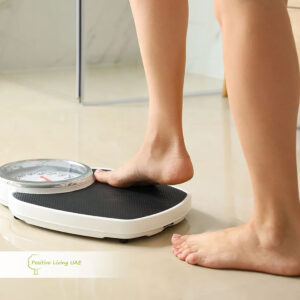What is Basal Metabolic Rate (BMR)?


A person’s Basal Metabolic Rate (BMR) is the rate of energy expenditure required to keep the body functioning whilst at rest. It is a measure of an organism’s capacity for growth, maintenance and reproduction. It also determines the rate at which an individual can burn calories, thus demonstrating an association with his or her body mass.
BMR is one of the most widely measured physiological traits; however, it exhibits significant variability across, and even within, species. In humans, age, gender, genetic background, and physical fitness level can affect BMR; with advancing age and reduced fitness levels contributing to a lower value. Higher muscle mass is associated with a higher BMR. Furthermore, in females, it is likely that BMR fluctuates slightly during the menstrual cycle, however, the studies on this are limited. A person’s BMR is also partially dependent on their genes, meaning that you can be genetically susceptible from birth to having a low or high BMR.
Calculating Metabolic rate
Metabolic rate is usually measured by calculating oxygen consumption or carbon dioxide production via indirect calorimetry. It is expressed as ml O2/min or joule per hour per kg body mass J/(h·kg) To be measured accurately, BMR should be taken in a temperature controlled, laboratory or clinical setting when a person is awake, inactive and postabsorptive (defined as the period of time that follows digestion and absorption of food by the body).
A person’s BMR can also be estimated using the Harris-Benedict formula:
- Males: BMR = 66 + (13.7 × weight in kg) + (5 × height in cm) – (6.8 × age in years)
- Females: BMR = 655 + (9.6 × weight in kg) + (1.8 × height in cm) – (4.7 × age in years)
The resulting value can then be modified by an activity factor to determine the daily calories required to maintain current weight. Most adults have an activity factor in the range of 1.2 (sedentary) to 1.5 (moderately active).
Therefore, for a 35 year old male who is 83 KG, 170cm tall and moderately active:
BMR = 66 + 1137 + 850 – 238 = 1815
Daily calorie requirement = 1815 x 1.5 = 2722.5
For a 35 year old female who is 65 KG, 162cm tall and fairly sedentary:
BMR = 655 + 624 + 291 – 164.5 = 1405.5
Daily calorie requirement = 1405.5 x 1.2 = 1686.6
BMR increases during pregnancy, by approximately 5, 10 and 25% across the first, second and third trimester respectively. Increases in BMR correlate closely with gestational weight gain. After delivery, exclusive breastfeeding is recommended for the first six months of a baby’s life. The average energy requirement for breastfeeding females is defined as that needed to maintain a healthy body weight, reasonable levels of physical activity and sufficient breastmilk production. Lactating females are recommended to increase their calorie intake by approximately 500kcal per day, however, BMR usually remains consistent for the duration of time that a female spends breastfeeding.
Alternatives to BMR
Resting Metabolic Rate (RMR) is a phrase used interchangeably with BMR; however, the conditions for taking this measurement are a lot less restricted and it can be calculated in a more informal setting.
The alternative to BMR and RMR is Maximal Metabolic Rate (MMR). This is calculated during periods of physical exertion when circa 90% of metabolic activity is associated with the working muscles and delivery of oxygen to the muscles. In contrast, basal metabolic activity is strongly associated with maintaining the homeostatic function of the body’s organs, including the liver, kidney, GI tract, heart and brain.
Can BMR be improved with exercise?
Whether or not improving fitness levels will alter BMR is controversial. Some studies suggest that weight training and high-intensity interval training (HIIT) can improve a person’s metabolic rate; however, others suggest that the effects of exercise on BMR are negligible. Regardless, maintaining reasonable fitness and partaking in regular exercise has many health benefits and should ensure a healthy BMI.
In conclusion, BMR is a tool widely used in the clinic, but the research on its physiological benefits seems limited and conflicting.
Sources:
- Douglas, Crystal C., et al. “Ability of the Harris-Benedict Formula to Predict Energy Requirements Differs with Weight History and Ethnicity.” Nutrition Research, vol. 27, no. 4, Apr. 2007, pp. 194–199., doi:10.1016/j.nutres.2007.01.016.
- “Human Energy Requirements.” FAO FOOD AND NUTRITION TECHNICAL REPORT SERIES, http://www.fao.org/3/y5686e/y5686e00.htm.
- Mcnab, Brian K. “On the Utility of Uniformity in the Definition of Basal Rate of Metabolism.” Physiological Zoology, vol. 70, no. 6, 1997, pp. 718–720., doi:10.1086/515881.
- Pettersen, Amanda K., et al. “Understanding Variation in Metabolic Rate.” The Journal of Experimental Biology, vol. 221, no. 1, 11 Jan. 2018, doi:10.1242/jeb.166876.
- Speakman, John R., et al. “The Functional Significance of Individual Variation in Basal Metabolic Rate.” Physiological and Biochemical Zoology, vol. 77, no. 6, 2004, pp. 900–915., doi:10.1086/427059.













































